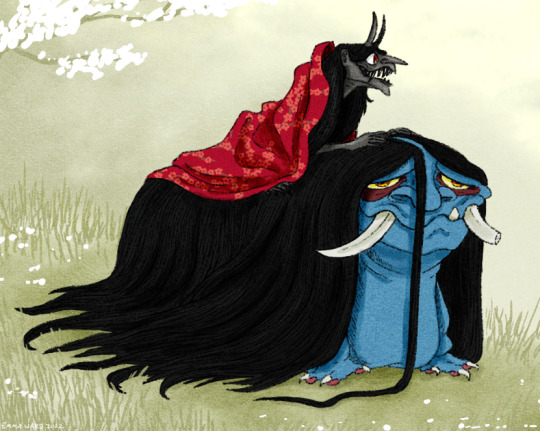#otoroshi
Photo

It is always important when out in the wilds to be wary of your surroundings. This may sound like a stupidly obvious statement, but you would be surprised at how many people have numerous blind spots whenever they trudge around outside. If you are like me and are out looking for cool creatures to see and study, keeping an open eye is crucial for spotting your target. This is combined with the fact that you should always be observant because being out here also means watching out for predators or possible threats. Certainly not every forest and field is filled with bloodthirsty beasts hungering for your flesh, but blind wandering around can stick you in bad scenarios if you are unlucky. Most creatures prefer to live their lives in peace, and would most likely just walk the other way if they spotted you. But if you so happened to ignorantly walk between them and their cubs, now we have trouble. Or if you stumble across a slumbering manticore and rudely awaken it with your presence. Not a good place to be. So be mindful of where you are walking and what is around you, and this includes looking UP! That is one of the major blind spots most people have, not bothering to look upwards as they walk. Sure, you want to keep your eyes on your roots so you don't trip, but one should give the occasional glance to the sky to make sure all is clear. We busy ourselves with the worries of coming across wolves or bears, all ground level threats, that we don't think that danger could be lurking overhead. This is one of the reasons why the species in this entry is rarely spotted, despite its large size. You tell someone that a giant black and blue haired cat is out there in the woods, and they would think it would be impossible to miss it. But folks do remain blind to it, which causes a real problem for them...
The feline I speak of is the otoroshi, a rather grotesque looking creature compared to its sleeker brethren. There is little lithe grace to be found in this species, with frog-like maws, hunched backs, bloated stomachs and a whole lot of black hair. Many would be surprised to learn that this is a cat, but folks that live around cypress swamps should not be too startled by this news. Indeed, the otoroshi is actually a close relative to the wompogo, which you should easily see from their features. Both possess this huge toothy maw and extendable stomach, signs that these felines like swallowing their prey whole. They both have large hooked claws that aid in both climbing and taking down prey. And when it comes to the hunt, these two love nothing more than hiding up in the trees and dropping down on those who wander below. The difference here is that the otoroshi does not live in cypress swamps, but in deciduous or coniferous forests. Any place that has big trees with hefty branches for them to lay on and wait for clueless prey, but honestly any high place will do. Some have been spotted on tall rocky outcroppings, while many will tell you that a roof or gate also serves the otoroshi's needs (but we will get more into that later).
Like their swampy cousins, otoroshi are ambush predators, preferring to take down their prey in one fell swoop. Like I mentioned, they climb up trees and tall structures then lay in wait amongst the branches. Otoroshi have short blue fur, which you would imagine would make it hard for them to hide, but such color is easily hidden by their ridiculous ebony mane. From the tops of their heads, running down their back and all they way to their stubby tails grows a waterfall of long black hair. It starts off as a short crest when they are kittens, but then it begins to grow and never stops. In a few years, this dark mane practically shrouds their entire body, hiding their blue under fur and allowing them to blend into the shadows. Up high and nestled in branches, one would have a hard time spotting them, that is if the victim even bothers to look up. Otoroshi remain perfectly still when they hunt, using their large eyes and flared nostrils to keep track of possible prey. When food finally walks beneath them, they drop down with all their weight and claws, easily knocking prey to the ground. The attacks are quick and decisive, with the fate of the victim being decided within the first few seconds. If they were able to dodge most of the assault and remain on their feet, then they can run away with ease. Due to the shape of the bodies and the nature of their limbs, otoroshi are not designed for the chase. They are slow and sluggish, never able to run after a fleeing meal. So instead they rely on knocking victims off their feet, or flattening them beneath their large bodies. When their food is downed, they can lash out with hooked claws and grab hold. Once this happens, prey is doomed. What comes next is its huge jaws, lined with bony spikes and curved teeth. Prey is shoved into this great maw, which can unhinge to accommodate even larger meals, and then slowly swallowed into its expanding stomach. There its smothering gut and potent stomach acid will deal with the hefty morsel, who will pass from asphyxiation in this foul melting pot. When its prey is consumed, the otoroshi will sluggishly make its way to a tree and crawl back up into the branches. There it will lounge and digest, living a lazy life until its great meal is reduced to nothing and its gut rumbles with hunger once again.
Though otoroshi live for those big belly-filling meals, it seems they will settle for small snacks if need be. Their diet involves large animals like deer, boar, bear and even human, but studies have found that they do eat a whole lot of birds. Not even big ones, mind you, little things like sparrows and doves. For a cat this size, it seems almost comical for them to be eating such tiny morsels! These birds are not taken down like their usual prey, instead the birds seem to land on them! While lounging or hunting, otoroshi remain a silent unmoving lump of hair. They look like a tangle of vegetation or just another shadow amongst the forest. In such a still state, birds are seen coming down to perch on them or the nearby branches, seemingly oblivious to the cat's presence. Some birds have even been seen pulling and tugging at the long dark hairs, perhaps thinking it could be good nesting material. When they land near an otoroshi, it will wait until their guard is dropped, then a clawed paw will lash out. Birds are crushed in its grip and then tossed into its maw. Why the otoroshi even bothers eating them is a question that has not been satisfactorily answered yet. Some think it is to stave off hunger while waiting for larger prey, but well-fed otoroshi have been seen picking off birds. Others think it is them trying to keep these birds from blowing the cover on their hiding spots, as a singing or foraging bird may cause possible prey to look up towards the noise. One less serious thought is that the otoroshi is a cat and what do cats do? Part of me thinks that perhaps these felines don't enjoy having their hair yanked by inquisitive sparrows, or getting a coating of droppings on their long locks.
While their mouths are filled with tiny hooked spikes, one should easily notice the pronounced canines that jut from their lips. Such large teeth would seem to be weapons against their food, a way to stab and gut victims who struggle. However, there doesn't seem to be any evidence that these teeth are used for hunting. Rather, it appears to be more for other otoroshi than prey. Both male and female otoroshi possess these tusks, so it isn't just the guys using them to fight over mates. Instead, it is believed that these large teeth help show age and health of each individual, allowing these cats to be able to eyeball possible competition. Prime hunting spots are fought after, but not everyone wants to deal with sharp claws and energy-wasting brawls. So we think they get around this by having tusks determine who is the victor in these squabbles, where younger cats can see an experienced veteran and know not to even bother trying to fight them for their turf. Some claim that these tusks are used to fight off predators, as it has been seen where attackers get gouged by these sharp teeth. However, close examination of these fights doesn't really show the otoroshi specifically using them to attack. Their movements and efforts do not suggest them wielding these teeth like weapons. Rather, we think these wounds are purely accidental, as the cat is really using its claws and huge maw to fight off attackers. When you are tangling with the huge jaws of an angry otoroshi, there is a high chance your struggle will cause you to stab yourself on these larger teeth.
As a big cat and an ambush predator, one could easily see them being a menace to the locals. Going about your day in the forest, when suddenly this gluttonous feline drops on your head and then swallows you whole. Not a fun time, but unfortunately one that has occurred numerous times. Otoroshi out in the wild are not too picky, any big animal will do for their belly. Humans (and even dryads) who don't pay attention to what hides above may trigger a cat to attack, and if they succeed in pinning you then you are going in the gut! So this is why it is important to watch your surroundings and be wary about going under overhanging branches or rocks. Folks around these regions have also used the mask trick to fool some otoroshi, where they think this second face means the human can see them. With such a dangerous reputation, you would think this species is reviled by all! However, it seems like they are not all despised.
I brought up before that otoroshi like any high places, and that could include roofs and gates. This is because otoroshi have been acclimating themselves to the encroaching civilization and have found new places to hunt. Forest shrines have nice gates for them to perch on, and the sprawling temples roofs have plenty of room. Even if prey isn't plentiful, it proves a wonderful place to stretch out in the sun and digest. One reason it is thought that otoroshi moved into these areas is because they found humans to be the perfect deterrent. Human towns do a good job at keeping out other creatures and large predators, and they also don't climb onto their roofs all that often. So a female otoroshi may find these places great for having her kittens, as all other threats are kept at bay by the human presence. Younger cats may have taken to the gates as new places to hunt, spots that haven't been claimed by elders. At first, it sounds like these invading felines were hated and driven away, but the problem is that they kept coming back. Shooing them off or even hunting them proved difficult, as they had the high ground and also caused a whole lot of structural damage if a fight broke out. Legend says that one shrine gave up on scaring off the haunting cat and instead offered a sacrificial deer to it. They knew that these cats gorged on a single meal and then lasted on it for days, even weeks. If they could give it a fully belly, then it would have no reason to harm them until it was hungry again. This trick worked, as the otoroshi ate the bait and then climbed back onto the gate for a snooze. Days went by without incident, as the cat merely watched those who passed by with lazy amusement. When it started to look like it was hungry again, another meal was presented and accepted. After a while, the keepers of this shrine found that the otoroshi was much calmer around humans and seemed to patiently wait for its next meal. Even when they were late with feedings, it didn't attack any visitors, rather it just grumble and yowled as a signal that it wanted food. Once a meal was given, it was happy once again. As a bonus, it even ate the birds that landed on the gate, keeping it free from their droppings.
This story is said to be the start of otoroshi "domestication," where several shrines and temples actually have them lounging about on their grounds. Folks of these areas see them as guardians and watchers, keeping their shrines safe from any evil spirits. Some claim that they can sniff out evil hearts or wicked intentions, and they will devour those foul souls who enter these sacred grounds. My counter to that is that vandals tend to make themselves quite loud and obvious, perhaps to the point of agitating one of these cats. Though they are accustomed to humans, that doesn't mean they won't fight back if given a reason to. These shrine otoroshi are given regular meals and offerings, which in turn keeps them peaceful and protective of their shrine. They stop associating humans as food but instead start seeing them as bringers of food. This is a neat little system that they have figured out, and I found it incredible when I visited my first shrine and saw a full grown otoroshi sprawled atop the gate. It is wonderful that they came to a peaceful coexistence, but I can't fully shake a part of me that sees trouble in it. I guess it is because some folks use the word "domestication" like these are just big house cats. I do not agree with this. An agreement has been made, that is for sure and a system has been set, but never would I say they have been domesticated. There are still parts of them that are instinctive and tied to their bestial nature, and I feel that having this romantic idea that they are adorable friendly pets can cause some problems. How many folk have tested their luck by trying to treat these creatures like house cats? When does the noise and constant presence of people start to grind their nerves? What happens if the agreement is not kept up by the humans? I personally wonder about these stories of otoroshi eating "wicked" people. Of the tales of a great cat dropping onto a nameless visitor and gobbling them, protecting their shrine from an "evil heart." Do these "guardians" actually pick out the bad souls or do the keepers of these shrines just claim them to be, so that the people cheer on what was actually a horrible accident? It isn't my place to say, but I will continue to wonder...
Chlora Myron
Dryad Natural Historian
-------------------------------------------------------
“Otoroshi”
Now lets follow up the last one with a Japanese Fearsome Critter! Gosh, they have some many of them they should really make a name for them!
14 notes
·
View notes
Photo

Here are some of my Japanese inspired pieces that will be at Rhode Island Comic-Con this weekend! If you are around come by! . . . #japaneseart#asianart#comiccon #rhodeislandcomiccon #japaneseart#landscspe#otoroshi#yokai#mt.fuji#samurai#samuraiart #artshow#artlife (at Povidence Rhode Island) https://www.instagram.com/p/CkhIAKUrt42/?igshid=NGJjMDIxMWI=
#japaneseart#asianart#comiccon#rhodeislandcomiccon#landscspe#otoroshi#yokai#mt#samurai#samuraiart#artshow#artlife
2 notes
·
View notes
Text
Inktober 19: Otoroshi
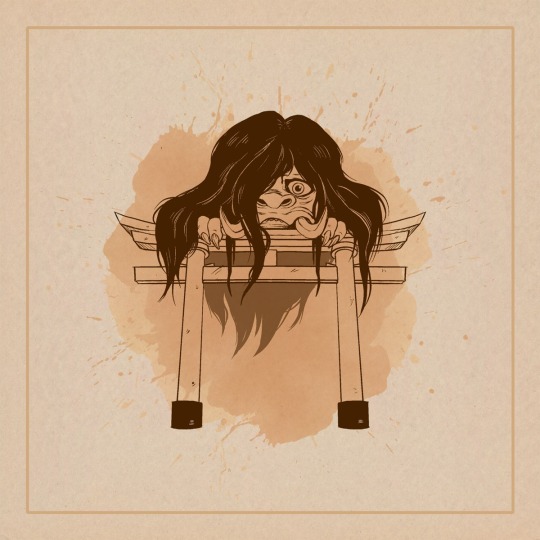
2 notes
·
View notes
Text
Ayakashi Hyakki Yagyo (あやかし百鬼夜行) Mobile Game Characters Part 1
I found another mobile game pertaining to Japanese Mythology and Folklore, but unfortunately it is not available in my region, but I was intruded by the story. There were also some beings from Chinese Folklore too, but I am planning on posting them in part 2. There are loads and loads of characters in this game, but I am going to start on the ones I saw so far:
[Character introduction] Ohikari (尾光, TailLight); A yokai fox with a golden tail. She is the one who invited the protagonist to the Hyakki Yagyō Tournament, and freely uses her girl and adult forms to guide the Hyakki Yagyō. The best partner for the main character, who has both innocence and toughness.
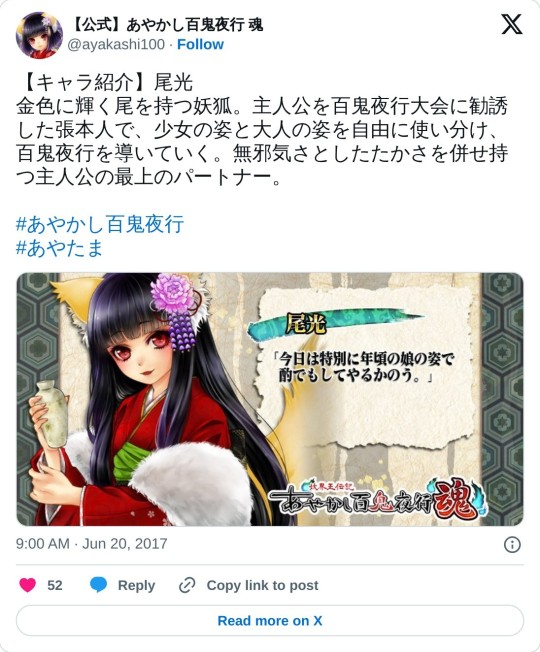
[Character introduction] Osaki (尾咲 Tail Blossom) is a young yokai fox with three tails and is a relative of Ohikari. She has a bad head, but a strong heart, and her weapons are toughness and luck. She mistakenly thinks that the main character is a ``horse bone yokai.'' She is very attached to Ohikari and doesn't seem to find the main character's existence interesting.

[Character introduction] Spirit dog Hayataro (霊犬早太郎) A spirit dog who bravely fought with an old monkey in place of a girl who was to be sacrificed, resulting in a trade. Loves walking, Loves bones. Feels very attached to everyone at Hyakki Yagyo. Sometimes sharp, but basically a dog.
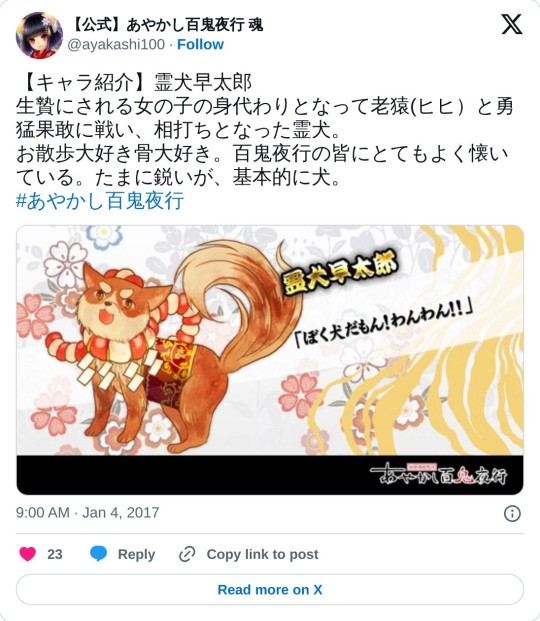
[Yokai introduction: Abacus Boy] (算盤小僧)The mysterious story of a young boy playing the abacus under a tree at a temple or shrine in the middle of the night. He is also said to be the spirit of a small monk who committed suicide after being scolded by a monk. In the world of yokai, while working at an employment information center, he volunteered his time as an accountant because he could not help but notice how lax financial management was at Hyakki Yako. Lately, he has been worrying about the cost of food for his bed.

[Character introduction] Karasu Tengu (烏天狗)(Mizubata (水端)) A tengu in the form of a bird of prey, wearing a Yamabushi costume. He has a crow-like beak and black feathers, and can fly freely.
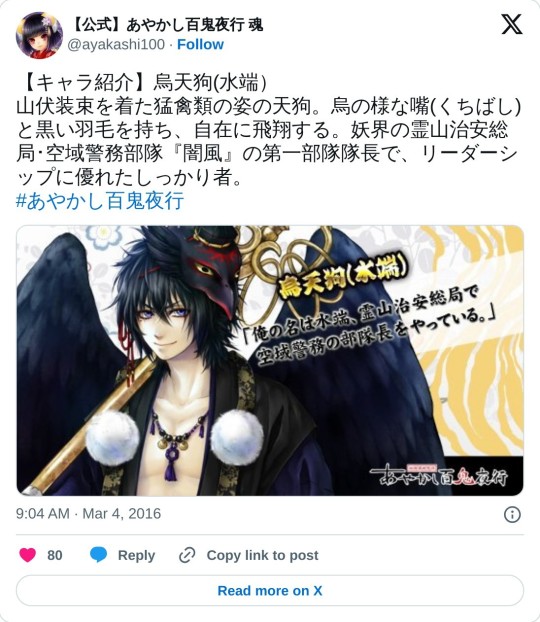
[Character Introduction] [Late Summer] Tama (タマ) of Ryuzoji Temple. The main character of the Nabeshima Monster Cat Riot. An incorrigible cat who turned into a monster cat and took revenge because her beloved master, Mataichiro, was killed. She has been a member of Hyakki Yagyo since the beginning, and will jump in whenever asked.
Note that I am not sure who her master is (not master as in teacher, but as owner or servant), but she is one of the characters who appeared so far in the game story mode I read.

[Character introduction] Nekosho 猫ショウ (Yuk (ユキ)) A Nekomata that has become even stronger through training. Yuki is one of the caretakers of Ennichi Yokocho, and is commonly known as Yuki-nyan. He is a good partner who understands and supports Ameri, who is too quick-witted and can be seen on a whim. He has many Nekomata disciples.

According to my research this is Ameri, but I will Ameri once I get to the part where he appears in the story.

[Character Introduction] Hohona (頬撫 Cheek Caress) and Oitekebori (置行堀)
A yokai that pats your cheeks and surprises you, and a yokai that demands you to leave behind the fish you caught. The close children duo of Hyakki Yagyo.

[Character introduction] Keippai (Another name for Otoroshi (おとろし) He is covered in long, unkempt hair and sits on top of the torii gate, and if something malicious tries to pass through the gate, he will fall down violently.
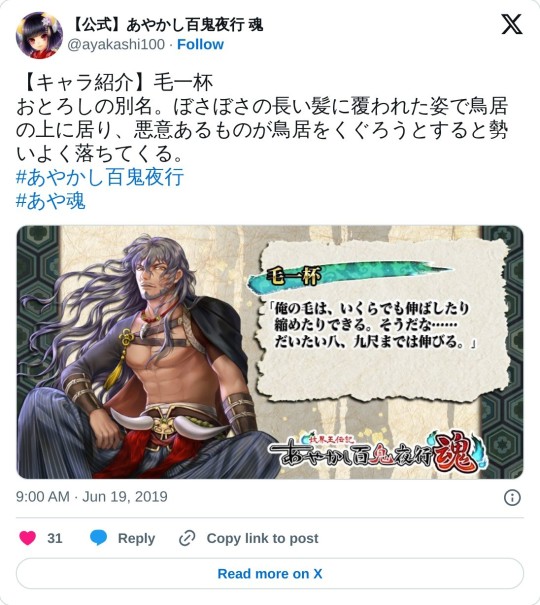
Note that I am guessing this is Otoroshi’s human form, which I haven’t seen yet.
#Hyakki Yagyo#Hyakki Yagyou#Hyakki Yako#Ayakashi Hyakki Yagyo#Ohikari#Osaki#Fox Spirit#Abacus Boy#Karasu Tengu#Mizubata#Tama#Nekomata#Nekosho#Yuki#Ameri#Hohona#Oitekebori#Keippai#Otoroshi
0 notes
Photo

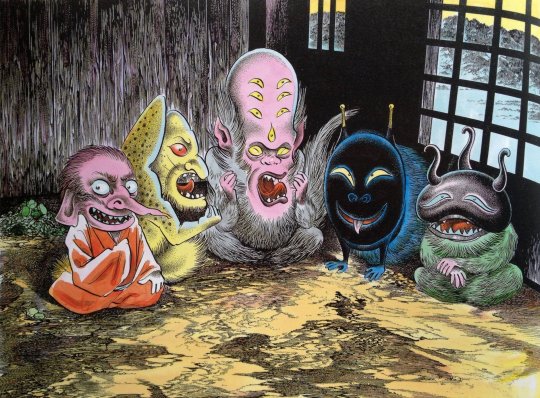

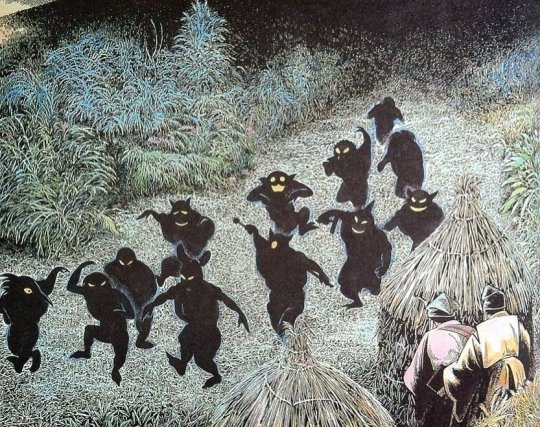
The hyakki yagyō is the dreaded night parade of one hundred demons—an event when all of the yōkai, oni, ghosts, tsukumogami, and other supernatural creatures leave their homes and parade through the streets of Japan in one massive spectacle of utter pandemonium. In many ways, it resembles a traditional Japanese festival, filled with songs and chants, dancing, and merriment. The parade is said to be led by nurarihyon, nozuchi, and otoroshi.
Hyakki Yagyō
Shigeru Mizuki - Yokai
269 notes
·
View notes
Note
is your oc a hashira?
Charlie? No, she's not. At the end of the first novel, she IS Hashira strength but never receives the title and would also refuse it anyway, since she feels she's not worthy of it.
If there's any question about her strength:
she's got a lot of experience fighting demons since she was quite literally trained by one, Akihiko, for several years before the canon timeline, and also because Akihiko would capture lower level yokai and oni for her to kill under his watch.
By the time she's captured and integrated into the Slayer Corps, she has at least 7 years of experience.
She is also taught by several Yokai under the order of Akihiko.
These Yokai include:
A Kappa ("brother kappa"), who teaches her how to move swiftly on land like he does in water and ALSO gives her the ability to manifest her oil breathing easier.
An old Inugami who imparts various knowledge and wisdom to her
An ancient Otoroshi who guards Akihiko's private shrine who teaches her how to stay hidden from view.
She also has experience with a Tengu, who is NOT under Akihiko's rule. He teaches her how to fight further and to temporarily harness her own spirit for a power boost. He teaches her this out of his own curiosity and amusement.
Akihiko is infuriated when he learns of this experience, because the Tengu could just have easily tricked and killed Charlie or taken her away.
All these experiences have gained her the moniker of 'yokai-friend', which is also sometimes used as an insult to her.
Because of her previous experience, she is also permitted to skip final selection and is assigned Kanoto rank at her acceptance into the corps. This of course causes issues with some other members.
thanks for the question~
3 notes
·
View notes
Text
Very late happy Halloween on Nov 1st(it was still Halloween when I started the drawing)
Here are some of my OCs I've never posted here before dressed up as characters from cult classic musicals. (Left to right: Corn the bake kujira as Seymour and his pet Aswang as Audrey 2, Fawl the basan as Frank-N-Furter, Oo the otoroshi as Jareth the goblin king)

#I'll post more about these sillies in the future#halloween#art#my art#digital art#illustration#digital illustration#artists on tumblr#oc#musicals#little shop of horrors#rocky horror picture show#labyrinth
6 notes
·
View notes
Text
wild hunt - chapter 5
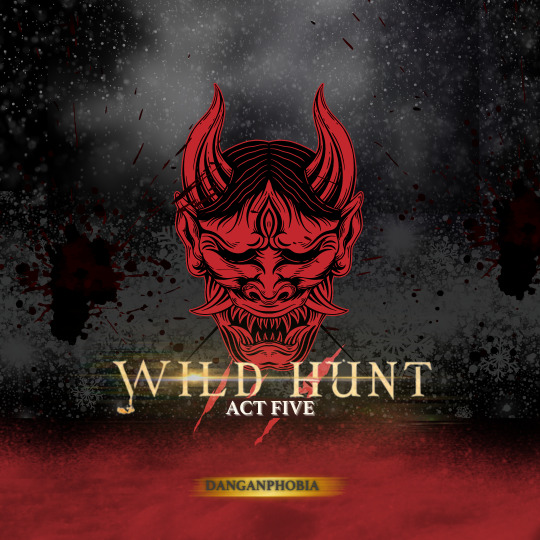
chapters: 5/7 | 63k+ | rated: m
As we move onward with our tragic and courageous tale, the one-armed samurai and the royal onmyoji leave Togo and ascend the highlands. A treacherous storm strikes, and the pair are prompted to find shelter from the cold Winter weather.
They are attacked by an Otoroshi, of which the wounds Kojiro endured will catch up to him later after saving Kaoru from the yokai. They end up in the Soeda farmlands, where two rōnin and two sorcerers are in dire need of their help when a tsuchigumo attacks the village.
Their identity and intentions are questioned by its residents, and their final night ends in an ambush that will change everything in the course of their journey.
read on ao3.
6 notes
·
View notes
Text
Stsil
A Bao A Qu
Aatxe
- Khalkotauroi
Abaia
Abere
Abuhuku
Adaro
- Zitiron
Adze
Afanc
Agrippa
Agropelter
Ahuizotl
- Ugjuknarpak
Airavata
Ajaju
Ajatar
Akaname
Akashita
Akheilos
- Isonade
Akhlut (Amarok)
Alp-Luachra
Amhuluk
Amikuk
Ammut
Amphisbaena
- Ouroboros
Anggitay
Aniwye
Aproxis
Apshait
Asanbosam
Asdeev
Aswang (Manananggal)
Awd Goggie
Banaspati
- Soucouyant
Banshee
- Limos
- Pesta
- Nemain
Barghest (Cadejo)
- Cu Sith
- Cwn Annwn
- Osschaert (Pesanta)
Bauk (Nalusa Falaya)
- Gaueko
Baykok
Berberoka
Berserker
- Einherjar
Binaye Ahani
Boitata
Boobrie
- Hverafugl
Bruch
Bubak (Tatty Boggle)
Buckrider
Buggane
Bukavac
Bulgasari
Bunyip
- Dingonek
Burach Bhadi
Burrunjor
- Kasai Rex
Butatsch
Byakko
Cactus Cat
Cacus
- Belacko
Caladrius
- Zhenniao
- Alicanto
Caleuche
Camulatz
Carbuncle
- Arkan Sonney
- Cagrino
Caspilly
Catoblepas
Cherufe
Chipfalamfula
Chochin-Obake
- Aoandon
Chon-Chon
Chupacabra
- Nadubi
Cipactli
Cockatrice
- Basilisk
- Codrille
- Aitvaras (Pukis)
Cuca
Cuero
- Rumptifusel
Curuara
- Inulpamahuida
Cyclops
- Papinijuwari
- Tartalo
Dijiang
- Hundun
Dire Boar (Erymanthian Boar)
- Bonguru
- Babi Ngepet
- Ao-Ao
- Cuchivilu
Djieien
Djinn
Doppelganger
- Fetch
- Frittening
Dorotabo
- Landvaettir
- Ahi At-Trab (Seitaad)
- Tsenagahi (Planctae)
Drop Bear
Dryad
- Radande
- Batibat
- Askafroa
- Yanagi-Baba
- Mandremonte
Dullahan
- Ankou
Ebajalg
- Hala
Echeneis
Egregore
- Ewah
Eintykara
Enenra
Erote
Fachen
Fad Felen
Fafnir
- Pixiu
Fomorian
Fossegrim (Nokken)
- Encantado (Boto)
Fulad-Zereh
Gaasyendietha
Gardinel
Garei
Gargoyle
Garmr
- Orthrus
- Cerberus
Gegenees
Girtablilu
Globster
Gloson
Goblin
- Nuno (Trenti)
- Kobold
- Grindylow
- Curupira
- Ijiraq
- Spriggan
- Pukwudgie
- Eloko (Chaneque)
- Likho
- Dactyl
- Bilwis
- Bugbear
Gold-Digging Ant
Golem
- Invunche
- Wulgaru
- Celedon
- Terra-Cotta
Griffon
- Sak
- Hieracosphinx
Grootslang
Gulon
- Rompo
- Taotie
Haietlik
Hantu Bulan
Harpy
- Siren
- Erinyes (Fury)
- Alkonost
- Lechuza
Heikegani
Hinnagami
- Jenglot
Hinqumemen (Engulfer)
- Umibozu
Hrimpursar
Hyakume
Hydra
- Orochi
- Ladon
- Nyuvwira
Ichneumon
Ikuchi (Ayakashi)
Imp
- Incubus
- Scarbo
- Bushyasta
- Skrzak
- Galtzagorriak
Intulo
Ipetam
Issitoq
- Aghash
- Aten
Itqiirpak
Ittan-Momen
Jba Fofi
- Tsuchigumo
- Aasivak
Jinmenju
- Wak-Wak
- Zaqqum
- Lunantishee
Jinshin Mushi
Jorogumo
Jubokko
Juggernaut
Kamaitachi
Kameosa
Kampe
Kappa
- Suiko
Karkadann
Karkinos
- Saratan
Kelpie (Each Uisge)
- Each Tened
- Helhest
- Apaosha
- Ceffyl Dwr
- Skinfaxi
Kerit
Keukegen
- Otoroshi
Kholkikos
Kikimora
Kirin (Qilin)
Kitsune
- Kumiho
Kongamato
- Ropen
Kurage-No-Hinotama
Lakuma
- Charybdis
Lamia
- Echidna
- Gorgon
Lavellan
Leprechaun
- Gancanagh
- Clurichaun
- Far Darrig
- Amadan Dubh
- Domovoi
Leshy
- Bies
- Anhanga (Waldgeist)
Leucrotta
Libelula Diablu
Longgui
Lou Carcolh
Lusca
- Iku-Turso
- Migas (Tree Octopus)
- Kraken
- Rogo-Tumu-Here
Makalala (Tuyango)
- Colorobetch
Makhai
Mandarangkal
- Empusa
Mandragora (Tiyanak)
- Davalpa
Manticore
- Sphinx
- Piasa
- Lammasu
Mapinguari
Marool
Minotaur
- Erchitu
- Sarangay
Miraj
Mishibizhiw
Mngwa
Morgawr
- Mamlambo
- Mokele-Mbembe
Moskitto (Xan)
Muhuru
- Mbielu-Mbielu
Muirdris
Musca Macedda
- Druj Nasu
Muscaliet
Muse
- Leanan Sidhe
Myrmecoleon
Nakshatra Meenu
Namazu
Nekomata (Cat Sith)
- Kasha (Ovinnik)
Nereid
- Rusalka
Ngoubou
- Odontotyrannus
Nidhogg
Nocnitsa (Mara)
Nosoi
Nuckelavee
Nue
Nurikabe
Olgoi-Khorkhoi (Death Worm)
Olitiau
- Popobawa
- Camazotz
- Guiafairo
Omukade
- Ek-Chapat
- Con Rit
- Kugdlughiak
Oread
- Lampad
Otso
Pard
Penchapechi
Peuchen
- Haemorrhois
- Seps
Piskie (Sprite)
- Ishigaq
- Phooka (Puck)
- Attercroppe
- Tooth Fairy
Polong
Poltergeist
- Dybbuk
- Isogashi
Poludnica (Lady Midday)
Psoglav
Qalupalik
Qinyuan
Qiuniu
Rahara
Raiju
Ramidreju
Rat King
Rawhead (Bloody Bones)
- Stuhac
Redcap
- Ly Erg
Roc (Ziz)
- Minokawa
- Thunderbird (Impundulu)
- Phoenix (Rarog)
- Psonen
- Tsenahale
- Nachtkrapp
- Naujakuksualuk
Rock Bolter
Roperite
Salamander
Salawa (Sha)
Satyr (Faun)
- Shurale (Mahaha)
Sazae-Oni
Scarab
- Khepri
Scorpios
- Sandwalker
Scylla
Sermilik
Shadhawar
Shen
Shinchu
Sianach
- Delgeth
Sigbin
Skinwalker
- Rougarou
- Selkie
- Bouda (Kishi)
Skolex
Sluagh
- Hidarugami
Spartoi
- Gashadokuro
- Tupilaq
- Mekurabe
- Ahkiyyini
Stella
Stray Sod
- Hungry Grass
Succarath
Tarasque
Tesso
Tiddalik
Tlanusi
Troll
- Kayeri
- Kapre
- Porotai
- Aigamuxa
- Yehwe Zogbanu
- Shellycoat
Trolual
- Raudkembingur
- Bakekujira
Umdhlebi
Valkyrie
Valravn
Veela (Sylph)
Velue (Peluda)
Vish Kanya
Vodyanoi
- Bagiennik
- Arzhavennik
- Bolotnik
- Cmuch
Wanyudo
- Ophanim
Water Leaper
Wendigo
Will o Wisp (Luz Mala)
Wyvern (Vouivre)
- Cuelebre
- Tizheruk
- Scitalis
- Knucker
- Suileach
- Caorthannach
Xhumpedzkin (Ix-Hunpedzkin)
Xiao
- Ahool
Xing Tian
Ya-Te-Veo
Yale
Yara-Ma-Yha-Who
Yowie
- Yeti
- Fear Liath
- Hidebehind
Yuki-Onna
Ziphius
Zirnitra
Zlatorog
Zmey
- Azi Dahaka
Zombie
- Draugr
- Mummy
- Topielec
- Corpo-Seco
- Gaki
- Aerico
Cat Sith / Pyrausta / Impundulu / Ninki Nanka / Khodumodumo / Minhocao / Marabbecca / Metminwi / Qupqugiaq / Myling / Moroi / Bloody Bones / Rokurokubi / Ifrit / Ghul / Ghawwas / Tiyanak / Mara / Acheri / Tikbalang / Baku / Calopus / Mahaha / Trollgadda / Tetragnathon / Vatnsandi / Ungaikyo / Naglfar / Oniate / Petsuchos / Sessho-Seki / Waldgeist / Tienlong / Tiamat / Asag / Hongaek / Ga-Gorib / Dalaketnon / Dobhar-Chu / Gbahali / Zheng / Antaeus / Maenad / Green Knight / Tulpa / Hiiden Hirvi /
11 notes
·
View notes
Text
Kliff: You’ve developed a mean streak, haven’t you, Ohana?
Ohana: You’re one to talk. The only reason why you got any fame is because you roasted a Scottish Otoroshi.
Kliff: In my defense, Robtish 100% deserved it.
Robtish: Touché.
#no straight roads#nsr#nsr kliff#pretty cure#happiness charge precure#aloha precure#power rangers#power rangers samurai#incorrect quotes#incorrect no straight roads quotes#incorrect pretty cure quotes#incorrect power rangers quotes#source: The Unused and Majin Show#source: Nominal Dingus#crossover quest
4 notes
·
View notes
Text
1 note
·
View note
Text
Taking Submissions: Otoroshi Journal 2023 Spring Issue (Early Listing)
Taking Submissions: Otoroshi Journal 2023 Spring Issue (Early Listing)
Submission Window: January 1st – 31st, 2023
Payment: $1 per accepted piece
Theme: horrorku, horror themed tanka, haibun, see below for details
The Submission may include any or all of the following:
· Up to seven (7) horrorku or horror tanka [we will rarely publish 5/7/5(7/7)]
· Up to three (3) haibun [title + prose + haiku/tanka — no more than 100 words]
· Up to five (5) pieces of cover art
All…

View On WordPress
0 notes
Photo
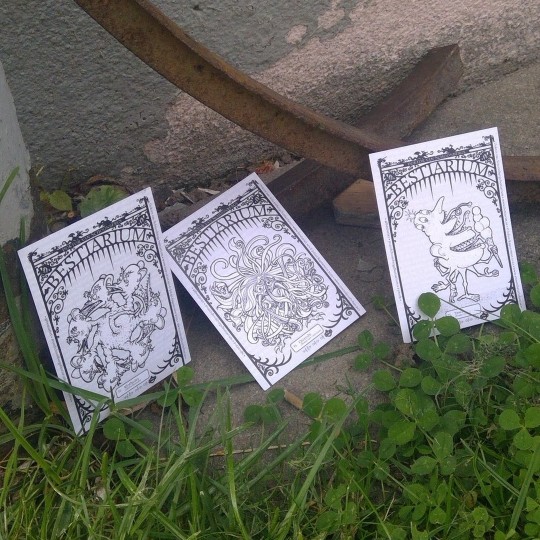
Skåda! Alldeles nytryckta samlarkort: #Klothydra, #otoroshi och #ynsch. Årets @vxozinefest blir av på lördag på @vaxjobibblan, och det blir första tillfället att alldeles gratis plocka åt sig dessa kort. Hittar du #SvenskaSuperserier , #NordensStjärnor, #BusterOchSara, #NinjaRövardotter och allt det där, så lär du hitta @ensomheterjohan, och då lär du även hitta #vanSchoonbergsBestiarium. Alltså dessa små monsterkort som man kan få gratis, och en del andra monsterprodukter som man kan få ogratis. #kreativitet #målarbok #monster #mytologi #folktro #japanskmytologi #hydra #yōkai #vxozinefest #vxozinefest2022 #evenemang #mässa #zine #fanzine #diy #Växjö #hejvxo #mittvaxjocity #serier https://instagr.am/p/Ci0K-TWo2Q4/
1 note
·
View note
Photo
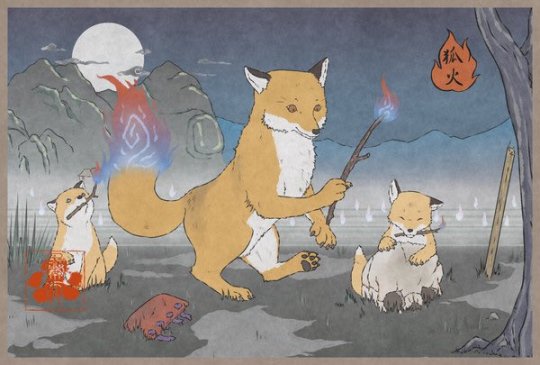
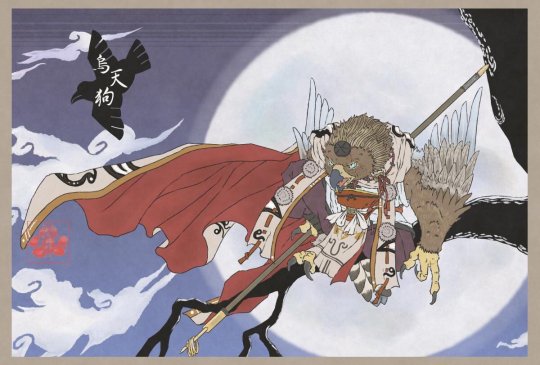

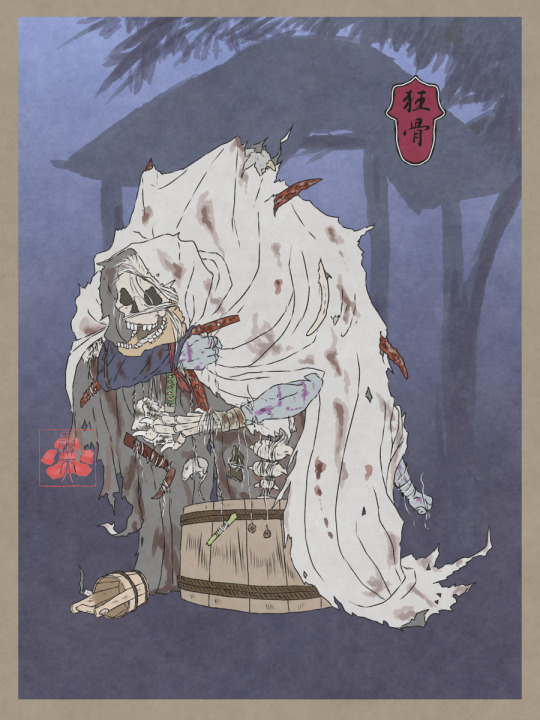

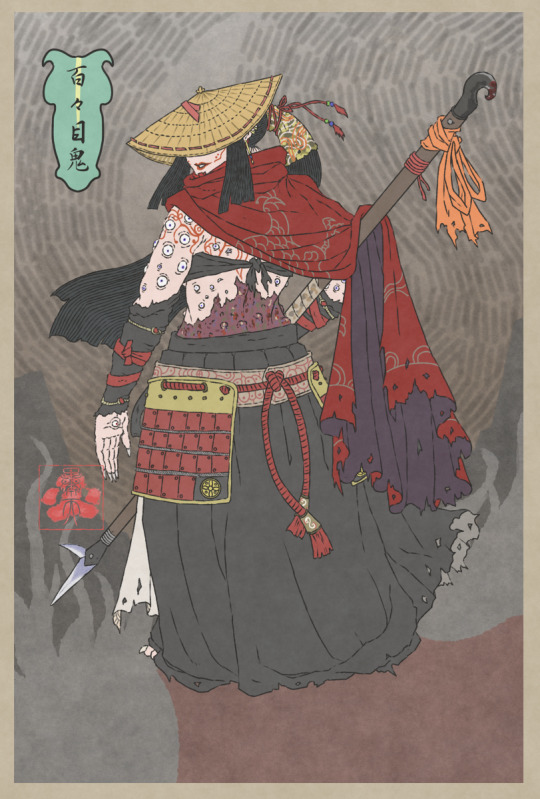
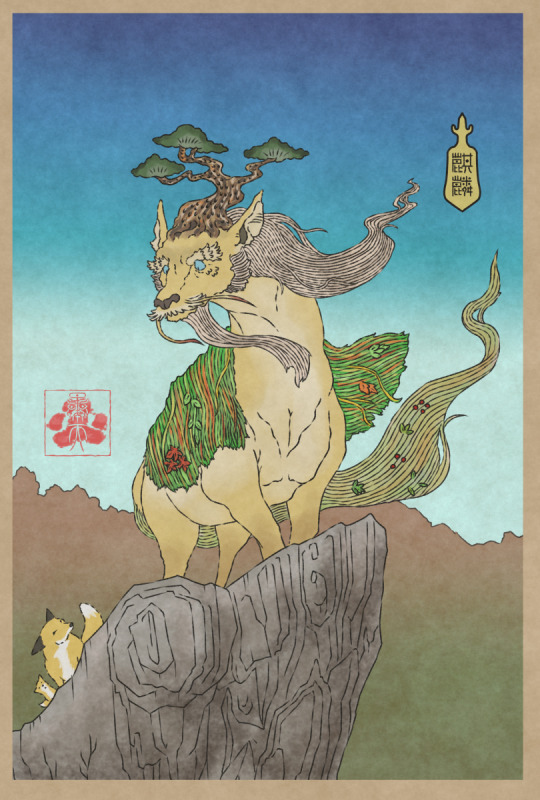
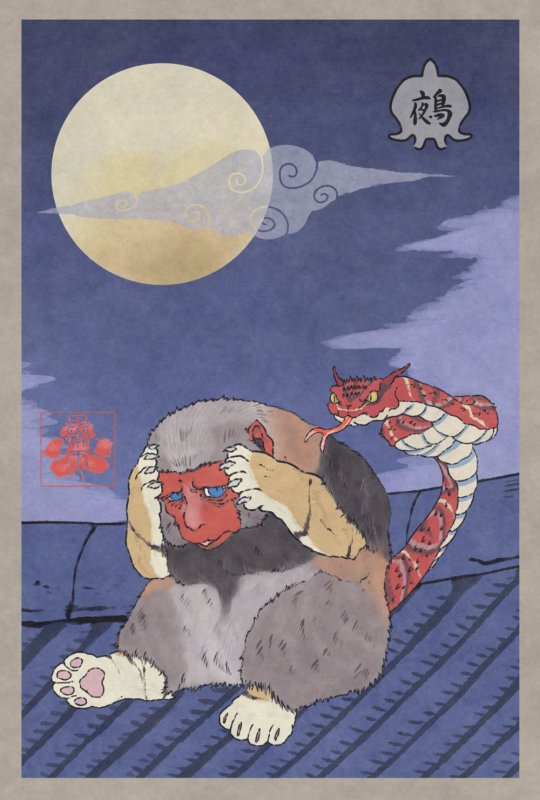
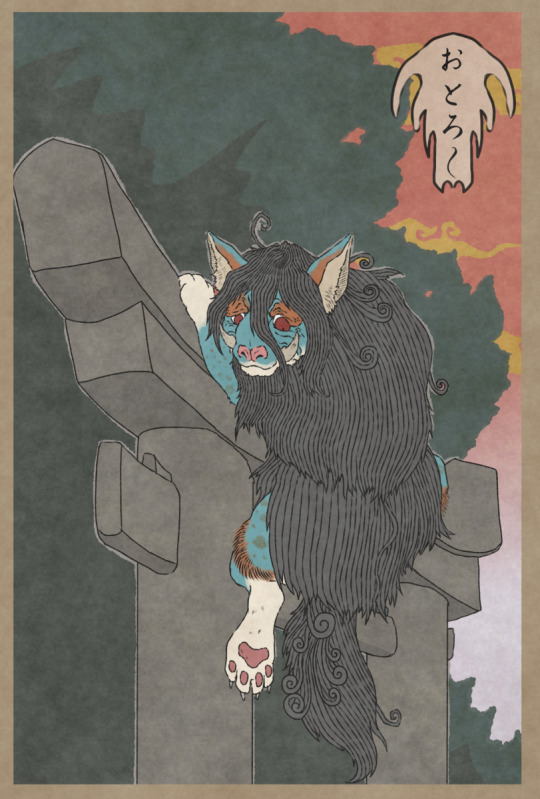
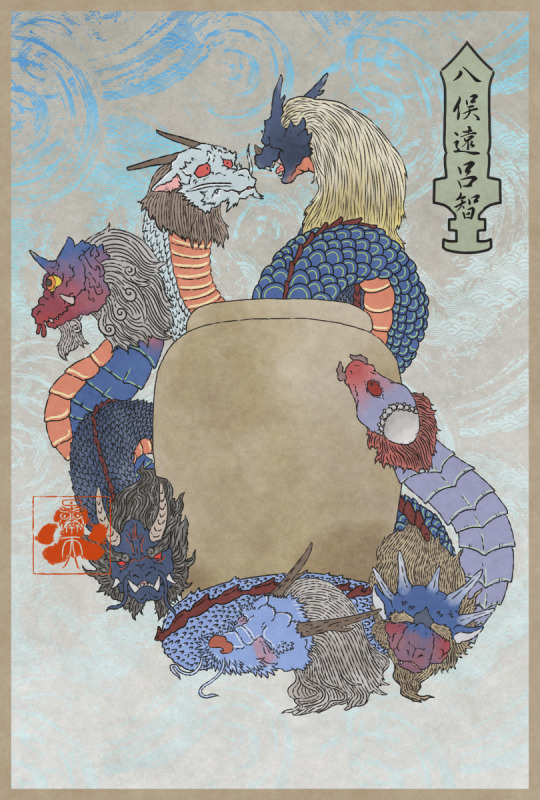
Yôkai monster portraits by Bouten (twitter / pixiv account), here are:
Kitsune bi (fox fires)
Karasu Tengu / Kotengu (crow Tengu / small Tengu)
Ittanmomen (cotton roll)
Kyoukotsu (bones in a well)
Kiyohime (Lady Kiyo, a snake woman)
Dodomeki (many eyes woman)
Kirin (Asian “unicorn”)
Nue (a kind a chimera)
Otoroshi (a kind of monster often perched on Torii gates)
Yamata no Orochi (eight-heads serpent)
#japan#art#youkai#yokai#monster#bouten#Kitsune#fox fire#kitsune bi#Karasu Tengu#Kotengu#Kyoukotsu#Ittanmomen#Kiyohime#Dodomeki#kirin#Nue#Otoroshi#Yamata no Orochi#Orochi
502 notes
·
View notes
Text

Gege Kusakabe now an Otoroshi because of a curse ⛩
2 notes
·
View notes
